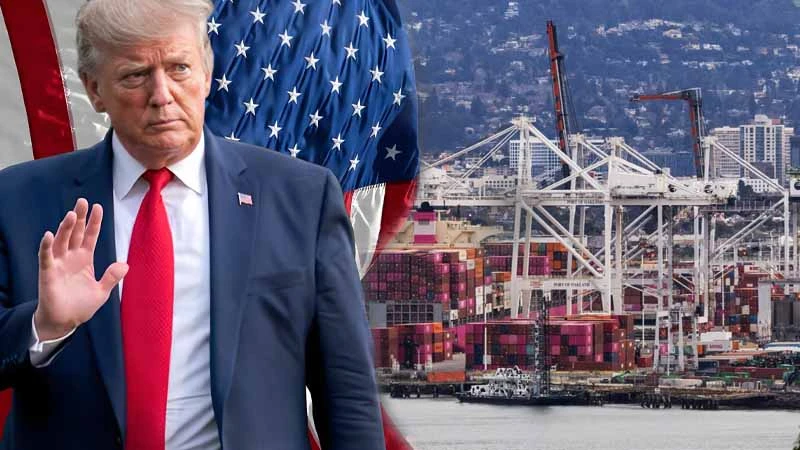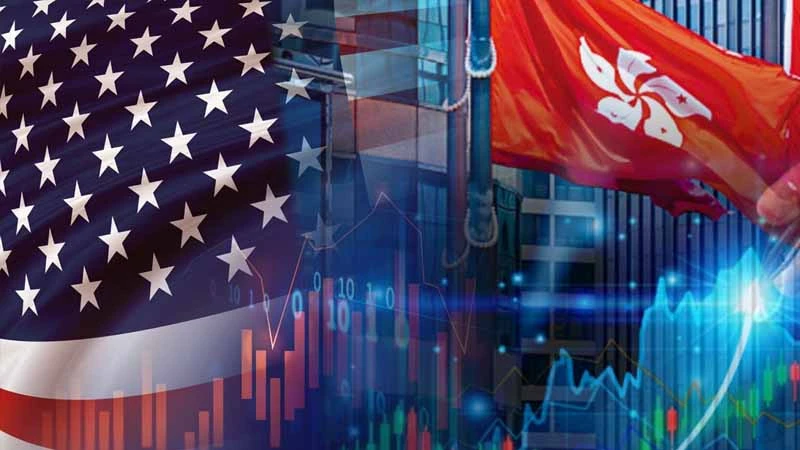Trump’s Tariff Hike Shakes Global Trade Landscape, Precious Metals Safe-haven Demand Continues to Rise
In February 2025, Donald Trump’s 25% tariff on imported cars triggered an instant earthquake in the global supply chain. This trade policy, which has been labelled “America First 2.0“, has not only forced multinational car companies to urgently reorganise production, it has also pushed the price of precious metals past the US$2,700 per ounce mark. While central banks are busy estimating the transmission path of imported inflation, the safe-haven aura of gold and silver has quietly become the lynchpin of the turbulent market – from industrial shocks to financial pricing, this tariff shock is reshaping the financial logic of the post-globalisation era with a rare penetrating power.
Trump’s New Tariff Policy: Drastic Restructuring of the Global Supply Chain
With Trump’s announcement on February 18, 2025, of a 25% tariff on imported cars, scheduled to take effect on April 2, the global trade system once again faces a major test. This move not only continues his “America First” policy stance but also signals a full-scale upgrade of unilateral trade policies. From steel and aluminum tariffs to the broad impact on the automotive supply chain, the US trade barriers are reshaping the international division of labor through “targeted strikes”. Against this backdrop, the safe-haven and financial attributes of precious metals are resonating, with gold prices consistently breaking key resistance levels and displaying rare strength.
The “Targeted Strike” Effect on the Automotive Supply Chain
This new tariff policy directly targets the automotive industry, with an impact far exceeding that of the 2018 steel and aluminum tariffs. According to Reuters, 28% of US imported cars come from Mexico, 18% from Canada, while German and Japanese carmakers have more than 60% of their plants in the US. The 25% tariff will force multinational carmakers to reassess their production layouts in North America, potentially triggering a regionalized restructuring of the value chain. Notably, although China’s new energy vehicle supply chain is not directly included in the tariff list, Tesla’s Shanghai Gigafactory component export business already faces potential risks.
The Crisis of Multilateral Trading System Collapse
The Trump administration’s imposition of unilateral tariffs, bypassing the WTO framework, has fundamentally shaken the post-war international trade order. Historical data shows that during the 2018-2019 US-China tariff war, the disruption of global trade rules increased multinational corporations’ supply chain adjustment costs by 12-15%. This latest round of auto tariff hikes may accelerate the operationalization of regional trade agreements (e.g., USMCA), creating a new paradigm where “tariff alliances” coexist with “non-tariff barriers“.
Inflation Spiral Risks and Tangible Impacts
The White House’s statement explicitly warned that “retaliatory tariffs will trigger escalated measures”, a policy flexibility that may unleash chain reactions. Historical data from 2018 shows steel and aluminum tariffs raised US manufacturing costs by 4.3%, while the new auto tariffs are projected to increase vehicle prices by 6-8%. More critically, the interplay between tariff policies and Federal Reserve monetary policy could compress the Fed’s rate-cut flexibility amid persistent inflation pressures, creating a “policy double whammy” effect.
Multi-Faceted Support Behind the Bullish Cycle in Precious Metals
Amid escalating trade tensions, the precious metals market is being driven by a combination of “safe-haven demand + monetary attributes + technical breakout”. Data from January 2025 shows that London spot gold rose by 2.73% for the month, breaking through $2,687/oz which is the largest monthly gain since June 2024. This strong performance reflects both the pricing-in of geopolitical risks and a signal of deeper structural shifts in the global monetary system.
Strategic Positioning by Institutional Capital
Futures market position data reveals the hedging strategies of institutional investors. As of mid-February, open interest in gold futures on the New York Mercantile Exchange increased by 3.2%, while implied volatility on silver options surged to 35%, marking a yearly high. This positioning indicates that professional investors are preparing for potential sharp market swings, with 12 consecutive weeks of net inflows into gold ETFs further reinforcing this trend.
Mirroring Historical Cycles
The current environment shares structural similarities with the 2008 financial crisis. During the 2008 crisis, gold prices surged by 29% annually, driven by safe-haven demand. This time, the combined impact of tariff shocks and rising global debt risks may trigger a more prolonged bull market in precious metals. Notably, global central banks increased their gold reserves by 1,136 tonnes in 2024, the highest level since the collapse of the Bretton Woods system, underscoring the strength of institutional buying support.
Structural Shift in Industrial Demand
The performance of the silver market is particularly noteworthy. Despite a technical correction of 1.55% in spot silver in early January, demand for silver paste in the photovoltaic and electric vehicle sectors continues to rise. Industrial silver is projected to account for 56% of total demand in 2025. This dual attribute of “safe haven + industrial use” makes silver a preferred balancing allocation in institutional investment portfolios.
Market Chain Reactions Amid Policy Games
The interplay between Trump’s tariff policy and major central banks’ monetary policies is creating complex market transmission mechanisms. The Federal Reserve’s January meeting minutes reveal that policymakers’ concern over “tariff-induced imported inflation” has surpassed the traditional dual-mandate framework of employment and inflation. This policy dilemma is even more pronounced among the European Central Bank and emerging market central banks.
Divergence and Coordination Dilemma in Monetary Policy
The European Central Bank’s unexpected rate cut in early February is seen as a precautionary response to potential tariff shocks. Banque de France Governor François Villeroy de Galhau explicitly stated, “Tariffs will not alter the eurozone’s inflation trajectory”, yet market pricing reflects a 0.4 percentage point downgrade in 2025 GDP growth expectations for the eurozone. This divergence in policy expectations could intensify exchange rate volatility, thereby enhancing gold’s role as a monetary alternative.
Defensive Strategies in Emerging Markets
The reaction mechanisms in Asian markets exhibit significant differentiation. Technology giants such as TSMC plunged 6% in a single day due to concerns over supply chain disruptions, while Indian electronics manufacturers benefited from expectations of “alternative capacity”, with stock prices rising 8.5% against the trend. This structural opportunity drives a two-way capital flow toward precious metals and specific industries, forming a unique risk-hedging model.
Multidimensional Responses of Institutional Investors
The strategy adjustments of multinational hedge funds are the most representative. BlackRock’s latest report shows that its precious metals-related positions in the global allocation portfolio have increased from 3.8% in Q4 2024 to 5.2%, while also adding short positions in Mexican auto parts companies. This “offensive and defensive” arrangement reflects institutions’ forecasts of prolonged trade conflicts.
Investment Insights under Structural Opportunities
In the face of escalating trade risks, market participants need to establish a multi-layered response framework. Historical experience shows that the actual impact of tariff policies often presents the characteristics of “short-term turbulence and long-term structural adjustment”, requiring investors to balance hedging allocations with opportunities in industrial chain restructuring.
Strategic Positioning of Precious Metals Investment
Physical gold and silver ETFs should be regarded as core defensive assets, with allocation ratios referring to the “10% basic position + dynamic adjustment within the volatility range” model. For investors with high-risk preferences, attention can be given to the leverage effect of gold mining stocks—data from January 2025 shows that the global gold mining stock index outperformed spot gold prices by 12%.
Regional Opportunities in Industrial Chain Restructuring
The value re-evaluation of Southeast Asia’s manufacturing hubs deserves attention. Thailand’s auto parts exports grew 9% week-on-week after the announcement of tariff news, indicating the substitution effect within regional supply chains. At the same time, the price elasticity of strategic resources such as Australian iron ore and Chilean lithium may become the next market focus.
Risk-Hedging Value of Technological Innovation
The trading volume of blockchain-based gold tokenization platforms surged 47% in February, reflecting the rise of digitalized hedging tools. This financial technology innovation not only enhances the liquidity of precious metals but also provides retail investors with new risk management tools.
Conclusion: Asset Allocation Philosophy in an Era of Uncertainty
When Trump’s tariff measures meet the hedging halo of precious metals, the market is writing a new pricing logic. This logic includes reactive responses to short-term policy shocks and embeds long-term predictions of profound changes in the global economic order. For investors, only by penetrating the noise and grasping structural trends can a solid financial fortress be built amid volatility. History will eventually prove that the real risk does not lie in sharp market fluctuations, but in turning a blind eye to the signals of epochal changes.
Frequently Asked Questions
Q1. Why do Trump’s auto tariffs particularly impact the global supply chain?
46% of cars imported into the US come from North American Free Trade Agreement members (Mexico and Canada), and over 60% of German and Japanese car manufacturers have plants in the US. A 25% tariff will force companies to reallocate production bases, triggering regional supply chain disruptions and soaring restructuring costs, creating “nearshoring” pressure.
Q2. What are the key triggers for the surge in precious metals hedging demand?
Aside from geopolitical risks, tariff policies and monetary policies have formed an “inflation spiral” expectation: the Federal Reserve’s room for rate cuts is constrained, the downward trend of real interest rates strengthens gold’s anti-inflation attribute, while silver is supported by demand from the photovoltaic industry, forming a “hedging + industrial” dual driver.
Q3. How does this tariff shock differ from the 2018 trade war?
The 2018 tariffs focused on basic materials such as steel and aluminum, while this time they precisely target end-consumer goods (automobiles), directly affecting CPI composition. Moreover, the current global debt-to-GDP ratio has reached 256% (an 18% increase from 2018), making the market less tolerant of policy shocks.
Q4. How can ordinary investors participate in the precious metals market?
They can allocate physical gold (5-10% of asset ratio), silver ETFs (such as SLV), or use gold mining stocks (such as Newmont and Barrick) to amplify leverage effects. While hedging, attention must also be paid to short-term fluctuations in the US dollar index and real interest rates.
Q5. Why does the European Central Bank’s rate cut accelerate the rise in precious metals?
The eurozone’s precautionary easing policy and the US “forced delay in tightening” have created a monetary policy divergence, causing depreciation pressure on the euro, which boosts the attractiveness of dollar-denominated gold and reinforces market expectations of global liquidity surplus.
Related articles
-
Since 2025, global financial markets have continued to focus on the monetary policy trends of the US Federal Reserve (Fed) and movements in the US Dollar Index. As a barometer of the international market, the performance of the US Dollar Index (DXY) directly affects asset prices and capital flows in...2025 年 3 月 18 日
-
2024 Q4 US Nasdaq Index plunged 3.6%, while the Hang Seng Tech Index fell 4.2% simultaneously, highlighting that the linkage between the two markets has deepened to the level of capital flows. Facing the Federal Reserve’s policy swings, the tech industry’s cyclical shifts, and rising geopolitical risks, Hong Kong stocks...2025 年 2 月 21 日
-
On February 20, 2025, the Australian Bureau of Statistics released the latest data showing that, after seasonal adjustment, the unemployment rate rose from the previous month’s 4.0% to 4.1%. This marks the second consecutive monthly increase since hitting a historical low of 3.46% in October 2022. Although the trend unemployment...2025 年 2 月 21 日













